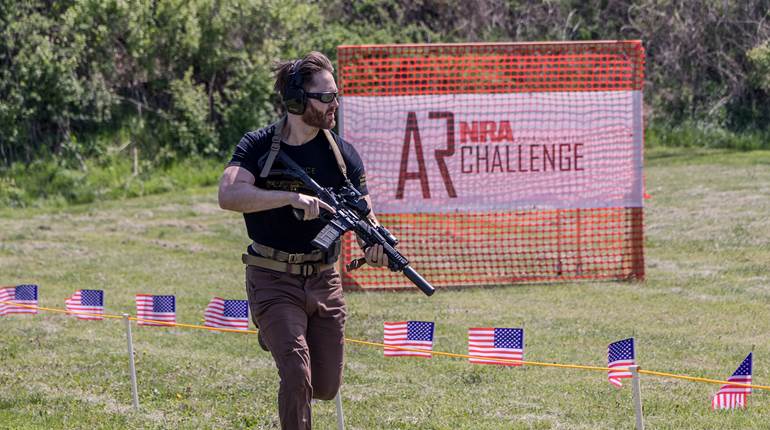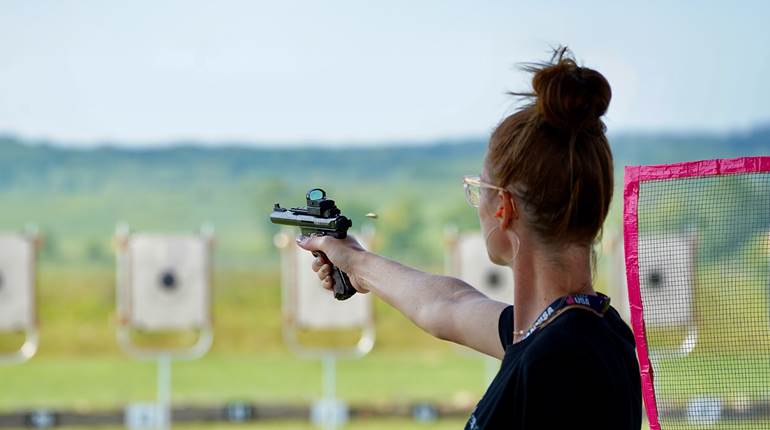
I never shall forget the feeling. My two squad mates and I approached the stand, a simple wooden platform with an enlarged shooting window at its front, ready for the “show pair” of clays at a large, NSCA-registered event. Rotating as we completed stations, a nationally acclaimed shotgunner was “up to bat,” followed by a novice and me, the “three-hole hitter.” As the leadoff prepared to call “pull,” I couldn’t help but notice that the dual muzzles of the neophyte’s over-under were pointing directly at my head, from only a few feet away.
In an effort to balance the stacked-barreled shotgun on his shoulder, like many of his competitors do, he inadvertently reversed the direction of the shotgun; it was pointing directly behind him. Granted, the action was open, so it couldn’t fire, but still it was a flagrant violation of basic gun safety. Stopping the call for the presentation birds, I asked the shooter to remedy the situation, which he did—and he apologized profusely. I don’t anticipate that happening again.
I’ve handled and shot firearms since I was old enough to physically support them and truly understand their safe use. From my origins, which consisted of squirrel hunting with my maternal grandfather’s vintage Winchester Model 250 lever-action .22 and trap shooting with a New England Firearms (NEF) single-shot .410, to today, where I currently compete at the highest levels of sporting clays (and FITASC) competition with a well-used Browning Citori CXS 12 gauge progressively losing its bluing. I’ve experienced a lot—mostly good things, but a few experiences have been nearly lethal.
I’ve witnessed negligent discharges, one of which was when a 20-ga. single-shot nearly removed a foot of mine, and I’ve been peppered by shot on three occasions while wingshooting. Trust me, speedy copper-plated No. 4 shot is rough on an unprotected neck (fortunately I recognized what was about to happen and turned, shielding my face). And that’s only the beginning. I mentioned these instances, as well as the example of the greenhorn competitor, not to frighten you, but rather to illustrate examples breakdowns of established gun safety rules.
There is an immense responsibility that comes with owning and using a firearm, and that’s ensuring the safety of yourself and others. Like other tools, a blatant disregard of safety practices will have consequences—some life-altering, other times lethal. So, what should you know and practice? That’s the intent of this article.
Firearm Safety
There’s no better place to begin a discussion about proper gun safety than with the NRA’s three fundamental rules. Each is detailed individually below.
First, always keep the gun pointed in a safe direction. Seems like common sense, but as you recall from the introductory paragraph of this article, it’s not always practiced; in fact, it’s easily ignored in especially stressful or exciting circumstances, such as self-defense, competition or hunting. This rule is particular important because, even if there were to be an “accidental” discharge—rarely the case, as it’s generally human error—the impact of such would be less severe. In general, a “safe direction” would be pointing toward the ground, away from appendages of yourself and others. Under most circumstances and in most environments, these are the safest directions, though only you can determine that.
Secondly, always keep your finger off the trigger until ready to shoot. Despite being demonized by the liberal Left and accused by those who disregard these very rules, hoping to place blame where it doesn’t exist, guns don’t think for themselves, and they never will fire randomly. Even in the most befuddling circumstance, something (finger, accessory, clothing, etc.) trips the trigger with the safety (or safeties) deactivated. The result: discharge. Premature discharges are particularly prominent in rifles featuring triggers with lighter-than-normal pull weights; however, you must still engage the trigger. So keep your finger clear of the trigger until you’re ready to fire.

Lastly, always keep the gun unloaded until ready to use. Simple. If you’re not ready to engage a target (or multiples) or aren’t actively hunting, keep the gun unloaded. An unloaded firearm, which has been visually and physically checked, with the action open, too, simply cannot fire. With this, even when hunting, unload the firearm when crossing obstacles, such as a streams or fences, unload the firearm and, if hunting with a partner, hand it over the fence to him or her.
Additional Rules
Beyond those three guidelines outlined above, there are other sage safety rules that should be followed. For instance, know your target and what is beyond. Think buildings, parks, buildings, people, livestock, etc. Once fired, you own that/those projectile(s), and you cannot recall it; whatever that projectile does downrange, you own it. Remember, projectiles from modern firearms travel great distances and have the ability to cause harm (or kill) at their farthest reaches, so it’s your responsibility to know the safe locations and directions to shoot.
Also, know how to properly operate your firearm, as well as know that it is safe to operate. When at the range, while using real ammunition, isn’t the place to discover your gun’s basic operating principles; learn these beforehand so that you keep yourself and others safe while having a more enjoyable and productive time at the range. If there’s any question about the resilience of your firearm, have it evaluated by a trustworthy gunsmith. The last thing you want is a catastrophic failure, which can result in injury or death.

Other NRA-recommended rules for using and storing guns include: use the correct ammunition for your gun (incorrect ammunition can render a gun inoperable at best or cause a tragedy at worst); never use alcohol, over-the-counter or prescription drugs before or while shooting; and store guns so they are not accessible by unauthorized persons. With this, know your jurisdiction's laws about storage and transport of firearms.
Finally, always wear eye and ear protection. I cannot stress enough the importance of this rule for maintain your quality of life. Unless you want to constantly ask, “Huh?” or “What did you say?” wear quality hearing protection. It’s so accessible and inexpensive, frankly, it’s just outright foolish not to—even when hunting.
As for eye protection, you want to preserve your eyesight at all costs. Imagine losing your eyesight for the sake of economy, effort or expediency. Let me share a story of how quickly and easily it can be lost. While hunting doves in Cordoba, Argentina, one of the hundreds of pellets sent downrange after a speedy dove deflected off the tip of a nearby branch, downrange from where we were hiding, and came back at us. It struck the eyewear—dead center—of my Bird Boy, spiderwebbing the lens. Rather than lose an eye, only a replacement of the glasses was needed—and which I happily provided with an upgraded model. I’ve never forgotten this event, and the importance of quality, impact-resistant eyewear when shooting. Consider what your vision is worth.
Obviously, this is not an all-inclusive course on firearms safety; rather, it’s a synopsis of the key elements. To learn more about gun safety and firearms training, make use of the many resources that the NRA offers.
When it comes to firearms safety, the adage, “familiarity breeds contempt,” holds especially true. Seldom are there true firearms accidents; rather, the individual(s) forget to enforce the basic tenets outlined above, and consequences are to be expected. Novice or veteran, male or female, old or young, firearm safety is your responsibility. Excuses aren’t accepted, and exceptions aren’t made.











































